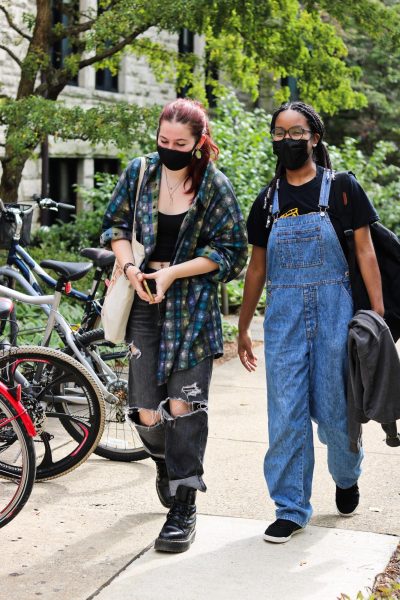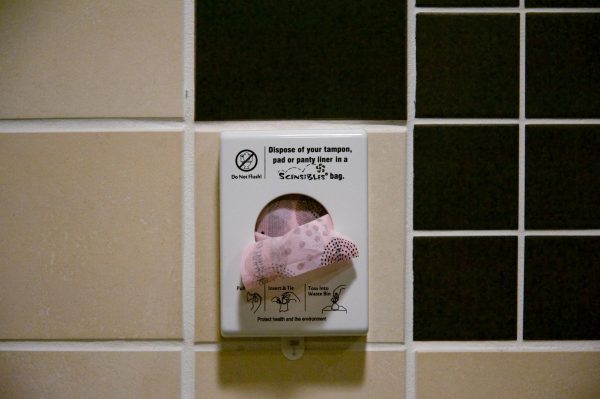Finding Masculinities That Work For Me
I was a sophomore in high school the year that former President Donald Trump was elected. In retrospect, it’s clear that a lot of the boys that I hung out with were struggling with depression. They spent our lunch hour playing video games and telling me why they supported Trump. Most of us dressed exclusively in jeans and T-shirts. I talked to my friends mainly about our shared hobbies or interests; personal lives were completely absent from our conversations. In most of my friendships, any affection was hidden behind a veil of apathy or competition.
I didn’t spend a lot of time with those people after that year. The social style didn’t work for me; I got tired of the constant competition, the casual disdain. Two years later, I came to Oberlin. I had never seen men express themselves in so many different ways. I had also never felt so comfortable exploring what it could mean to me to be masculine, or not. What follows are some stories about my experience with different masculinities and experimenting with femme presentation and social modes as a cisgender man at Oberlin.
One night I was sitting with a group at Stevenson Dining Hall eating dinner, and we were talking about one friend’s recent romantic troubles. She said, “Yeah, men are just the worst.” And then, to the men sitting with her, “But not y’all.” I think she meant that she was angry at a man because he was acting in a way that hurt her. She thought there was something about him being a man that hurt her. He represented to her, in that moment, the patriarchy. I think the discourse regarding men at Oberlin is framed primarily around politics, which is really useful for understanding patriarchal power structures. However, it too often becomes generalized.
Coming to Oberlin opened up my understanding of the different ways that people can express and play with gender. There was this guy in my first-year dorm who wore heeled cowboy boots, tight pants, and patterned shirts with one more button undone than would be appropriate in a job interview. I would often see him hanging out in the Barrows Hall commons. He always looked amazing, and he smiled a lot, and I thought to myself, “That’s how I want to be.”
A year and a half later, I ran into a different friend on the way to a party on South Campus. Coincidentally, we had also met in Barrows during my first year, but the social isolation and shrinking of social circles that came with COVID-19 restrictions had pulled us apart. We hugged each other when we got close enough. He was wearing a tank top with an open button-down over it, and a flowery, flowy skirt. He looked amazing, and I thought to myself again, “That is how I want to be.”
For me, there was something special about how each of these people presented, something that I saw and wanted to emulate. But they’re very different people, presenting in very different ways. In truth, there aren’t only two essential or universal models of masculinity encapsulated by “healthy masculinity” or “toxic masculinity,” just like there’s nothing universal about masculinity or men. Framing the discourse solely around “toxic” versus “healthy” masculinity erases femininity and androgyny as legitimate options for men. One thing that’s special about Oberlin is the acceptance of men exploring these different masculinities, femininities, and androgynes, and finding versions that work well for us.
I went through my first breakup at the beginning of the summer semester. I had never felt so anchorless. Before Oberlin, I had always had my family to talk to about what was going on in my life. And I still did — the cell phone is an amazing invention — but the physical presence that we all learned was so important over the last year wasn’t there. What I had were my Obie friends. Before I came to Oberlin, many of my friendships were atomized, jokey, and competitive. While this isn’t a bad thing in itself, I didn’t feel comfortable making friendships that I could rely on to support me when I was going through a hard time. It was at Oberlin that I learned how to sit down with a friend and cry on their shoulder. Here, when I tell a friend that I’m having a hard day, or week, they ask if I want a hug. And it’s not like I don’t have friends that I am jokey and competitive with; I really value that mode of friendship. But those supportive and affirming friendships are important to me as well, and the tools to build those friendships weren’t always apparent in the masculinities I encountered outside of Oberlin.
At Volunteers of America, the one in North Olmsted, I browsed clothes with one of my best friends. If you’re not familiar with Volunteers, it’s a beast of a thrift shop, with high industrial ceilings and long racks of clothes sorted by color. I took two dresses, two skirts, and a button-down shirt to the dressing room, and left the store with a dress, a skirt, and a button down. Wearing the skirt later, I expected weird looks. Instead, I was surprised by a flood of Oberlin’s positivity and affirmation. This is something I’m really thankful for at Oberlin, and I think it represents the next step in discourse around men and masculinities. If a general and political discussion of the patriarchy is the first step of that discourse, then the second step is men asking, “How do I want to be? What gender presentations — masculine, feminine, or androgynous — work for me?” The final step is doing it.
Self-building is a never-ending and context-dependent process, and I’m certainly not done. I’m still finding out what modes of presentation and what social roles work for me. However, I am thankful that I get to become myself, at least for the next few years, at Oberlin.




